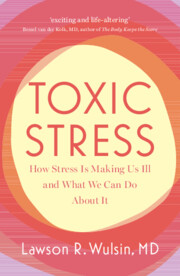Book contents
- Toxic Stress
- Reviews
- TOXIC STRESS
- Copyright page
- Contents
- Introduction: Your Body’s Hidden Symphony
- Part I The Problem
- Part II The System
- 4 Our Resilient Stress Response System
- 5 Symphony in 10-Flat by Usain Bolt
- 6 Resilience for Life – Yours
- 7 Fast Tracks to Dying Young
- 8 Scan the Lifespan
- Part III Measuring Toxic Stress
- Part IV Treatment
- Part V Our Next Frontier
- Appendix
- Acknowledgments
- Notes
- References
- Index
- About the Author
8 - Scan the Lifespan
from Part II - The System
Published online by Cambridge University Press: 18 April 2024
- Toxic Stress
- Reviews
- TOXIC STRESS
- Copyright page
- Contents
- Introduction: Your Body’s Hidden Symphony
- Part I The Problem
- Part II The System
- 4 Our Resilient Stress Response System
- 5 Symphony in 10-Flat by Usain Bolt
- 6 Resilience for Life – Yours
- 7 Fast Tracks to Dying Young
- 8 Scan the Lifespan
- Part III Measuring Toxic Stress
- Part IV Treatment
- Part V Our Next Frontier
- Appendix
- Acknowledgments
- Notes
- References
- Index
- About the Author
Summary
How fast or slow does the process of dysregulating the stress response system go before a disease emerges? This chapter builds a model for how this process works over the lifespan. The apparently sudden onset of diabetes or heart disease in our fifties or sixties can often be traced to dysregulations that began years or decades before, invisible to the unsuspecting and asymptomatic. Toxic stress accelerates illness and speeds up aging. How do we know if we’re on a fast track to future illness and early death? And when is the best time to intervene? That depends on how we measure stress. Consider Teresa Langford’s pathways from genes to stress to illness over 53 years.
- Type
- Chapter
- Information
- Toxic StressHow Stress Is Making Us Ill and What We Can Do About It, pp. 151 - 176Publisher: Cambridge University PressPrint publication year: 2024

